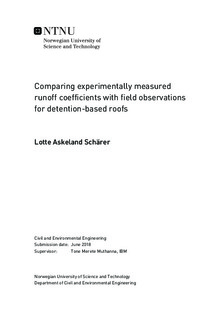| dc.description.abstract | Predicted climate changes combined with urbanization increases the performance demand on urban stormwater management structures. The rational method with the runoff coefficient (C) is one of the most commonly used design tools in urban stormwater design. In Norway, detention-based roofs are gaining popularity as a stormwater management measure. More knowledge is needed on the runoff coefficients from these roofs in order to improve design calculations. This thesis compares laboratory and experimental field studies to investigate runoff coefficients from different types of detention-based roofs. The laboratory measured runoff coefficients are found by the standard German method given in the FLL Guideline . Runoff coefficients for both single layers and combinations of these layers are found. The Leca-based roof systems gave the lowest runoff coefficients, with C = 0,33 and C = 0,29. The two other detention-based roof systems got higher values of C = 0,84 and C = 0,74. By comparing these values to the coefficients for the single layers, it becomes clear that the value of the runoff coefficient is mostly determined by in which of the layers the horizontal flow occurs. The runoff coefficients from the field were calculated using observed precipitation and runoff from existing green roofs in Oslo, Trondheim, Sandnes and Bergen, all cities representing a cold and wet Norwegian costal climate. The single events chosen as most comparable to the laboratory events based on precipitation, gave significantly lower and varying runoff coefficients. In this way, the study shows the runoff coefficient as a complex value, and highlights the challenge, if not the impossible task, of choosing a suitable runoff coefficient for a given roof. However, laboratory experiments are important in understanding the underlying flow processes in the different layers in a detention-based roof. | |

